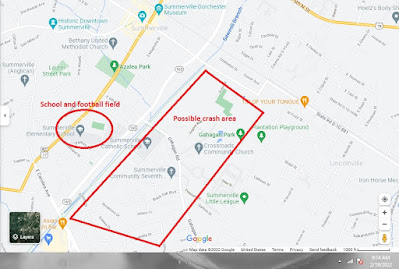 |
| Former Sheep Island Road. |
"Betty Jo watched it come in from the east. She saw parachutes begin to open in the sky one by one. Ten in all opened as the plane began to make circles...and as it flew over, she recognized the large bomber. It was one of ours. The plane was a B-24 Liberator Bomber...The plane began to level out. In his classroom, Bobby Anderson was staring out the window...It barely cleared the store across the street before clipping the treetops...it sputtered along the trees and disappeared...Bobby and his classmates jumped to their feet, raced across the classroom and out the door. They gathered on the football field with the other students and watched the little white parachutes drifting in the April sky...The young boys raced around the teachers and down the path...The boys reached the smoking wreckage and began scavenging souvenirs from the crash site before the authorities arrived...The townspeople lined the road on foot, on horseback, in wagons, and in cars as they hurried to the burning plane...Eventually, the town authorities showed up and extinguished the flames. The military showed up and retrieved what it wanted. Then the bulldozers showed up and buried the rest."
The incident occurred on April 4, 1945.
As you glean the story's passages, you notice the usage of landmark identifiers, such as Town Hall, treetops, a store, a school, and a football field. Also, there would need to be a unpopulated space on the edge of town large enough to accommodate a crashing bomber. A bomber armed with eleven .50 caliber machine guns, carrying a payload of eight sixteen-hundred-pound bombs, weighing in at about fifty-five thousand pounds, and possessing a wingspan of 110 feet. The section of town containing all those characteristics likely puts the crash scene along South Main Street and east just beyond Sawmill Branch.
 |
| South Main Street and the school. |
 |
| The football field. |
 |
| The store. |
Mysteriously, a comprehensive search revealed no Charleston newspapers reported the crash, and that includes newspapers everywhere. The Air Force Historical Studies Office, which maintains records, historical data, and archives, officially maintains the ditching of a B-24 Liberator Bomber never occurred on that date in Summerville, SC. Secrecy was a key element during World War II, and censorship did not want that information to be broadcasted. The war ended September 2, 1945--put it in the X-Files along with Area 51 and the Devil's Triangle. It seems more than just a bomber was buried on that fateful day.
There are a few unexplainable chinks in the telling. According to the story, no one was in the aircraft at impact. All occupants safely exited via parachutes, which included the pilot. I find that difficult to accept. It would mean the pilot, at a safe elevation for deploying a parachute, abandoned his aircraft over a civilian population to crash where ever it may. Any responsible pilot would not have permitted that to happen.
No one knows what the plane was doing and why it ended up flying over Summerville. Speculation was it had been patrolling the coast searching for Nazi U-Boat submarines, but that would have been an assignment for a fighter more so than a bomber. Also, why didn't the pilot ditch the failing aircraft into the ocean, unless he lost total command of the primary flight controls and couldn't do so, but that hypothesis can be quickly dismissed since the pilot was still capable of circling the town.
Despite the notable chinks in the story, the named eyewitnesses Betty Jo Waring and Bobby Anderson cannot be ignored, not to discount a whole school of students and school faculty. Consulting the crew and pilot would be futile, they would be obliged to take an oath of confidentiality. One thing is for sure, the bell in the town hall bell tower would have rung out, thus alerting the firefighters and townspeople of the catastrophe. It served as a fire alarm for the town, indicating by a predetermined sequence of rings what part of town was on fire to direct the volunteer firefighters to the correct location.
Many years have passed since April 4, 1945. Still, there is possibly somebody out there who knows the truth. The question: Who are you, and are you willing to come forward and shed some light on this Summerville mystery?
Otherwise, mystery sleuths, get out your magnetometers and ground-penetrating radar equipped drones, there is a deeply hidden secret needing to be unveiled. This could be a venture requiring the expertise of Josh Gates and Expedition Unknown. Without a doubt, "The Phantom Flight Over Summerville" would make a good Twilight Zone episode.















